|
Volume 2013/14, Issue 2
| October 8, 2013 |
|

Stanislaus River Salmon FestivalOctober 26
|
|
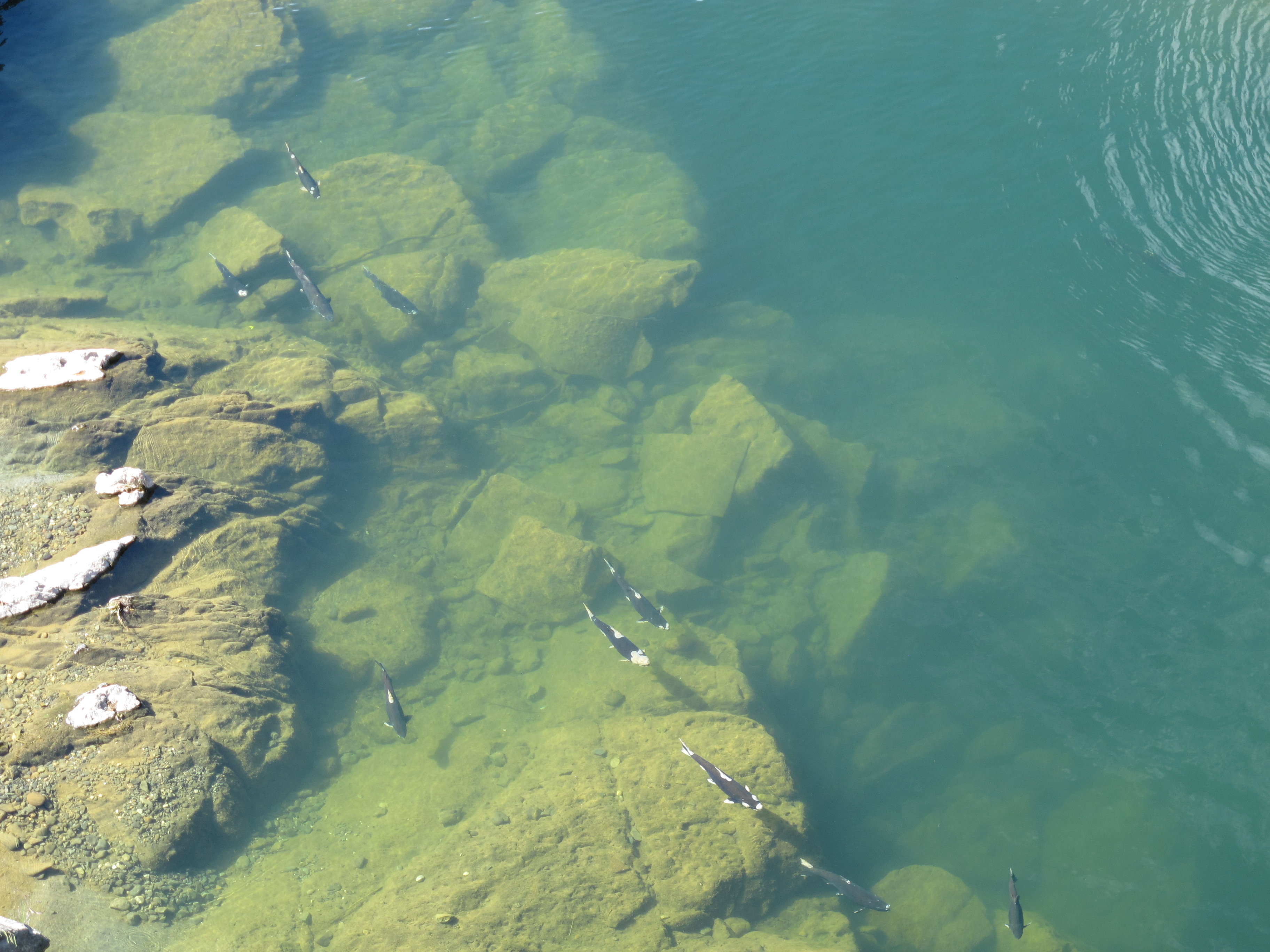
|
Key Highlights
September 2, 2013 - September 29, 2013 Stanislaus River Weir Monitoring continued and 373 Chinook salmon passed upstream through the weir between September 2 and September 29. Tuolumne River Weir Monitoring resumed on September 24. A total of 26 Chinook salmon passed upstream through the weir between September 24 and September 29. Mokelumne River Woodbridge Dam Fish Ladder Monitoring continued and 4 Chinook salmon passed upstream of the dam between September 2 and September 29. San Joaquin River Conditions. San Joaquin River flow at Vernalis increased from 502 cfs to 1,508 cfs. Daily average water temperature in the San Joaquin River ranged from 63.6°F to 76.3°F at Vernalis, and from 64.5°F to 77.2°F at Mossdale. Daily average dissolved oxygen (DO) in the San Joaquin River ranged from 8.3 mg/L to 11.4 mg/L at Mossdale, and from 6.7 mg/L to 8.3 mg/L in the deep-water ship channel (measured at Rough 'n Ready Island). Delta Exports. Combined total exports (state and federal pumps) fluctuated during the reporting period, ranging from 4,211 cfs to 9,101 cfs.
|
|
2013 Stanislaus River Weir Adult Migration Monitoring
Between September 2 and September 29, a total of 373 Chinook salmon were detected by the VAKI Riverwatcher (Figure 1). Daily passage ranged between 0 and 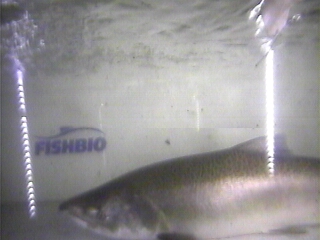 74 Chinook salmon. During the 2012/13 monitoring season, a total of 7,248 Chinook salmon were counted (Table 1) and the Pacific Fishery Management Council (PFMC) is predicting similarly high returns the Central Valley in 2013/14. 74 Chinook salmon. During the 2012/13 monitoring season, a total of 7,248 Chinook salmon were counted (Table 1) and the Pacific Fishery Management Council (PFMC) is predicting similarly high returns the Central Valley in 2013/14.
One O. mykiss was detected passing upstream during the reporting period. A total of 100 O. mykiss were counted passing upstream through the weir during the 2012/13 monitoring season.
Instantaneous water temperature measured at the weir ranged between 58.7˚F and 68.1˚F, and daily average water temperature at Ripon (RPN; RM 15) ranged between 63.5˚F and 74.2˚F (Figure 3). Instantaneous turbidity ranged between 0.50 NTU and 2.37 NTU (Figure 4). Instantaneous dissolved oxygen at the weir ranged between 7.99 mg/L and 9.43 mg/L, and daily average dissolved oxygen at Ripon (RPN; RM 15) ranged from 7.69 mg/L to 9.01 mg/L (Figure 5).
Daily average flows in the Stanislaus River at Goodwin Dam (GDW; RM 58) ranged from 202 cfs to 213 cfs. Flows at Ripon (RIP; RM 15) ranged from 241 cfs to 277 cfs (Figure 1). Note: flows downstream of Goodwin Dam may differ from dam releases due to irrigation, precipitation, and other factors.
Table 1. Annual fall-run Chinook passage at the Stanislaus River weir, 2003-2013.
Figure 1. Cumulative passage of fall-run Chinook salmon recorded at the Stanislaus River weir from 2003-2013.
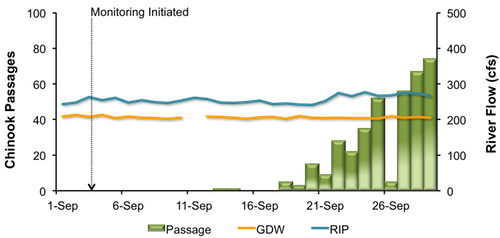
Figure 2. Daily upstream Chinook passage at the Stanislaus River weir in relation to daily average flows (cfs) recorded in the Stanislaus River at Goodwin (GDW) and Ripon (RIP), 2013.
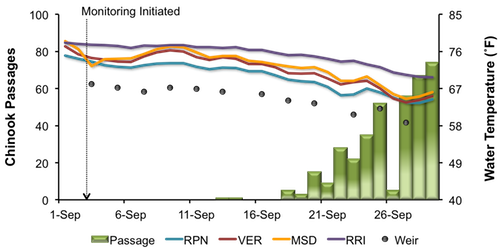
Figure 3. Daily upstream Chinook passage recorded at the Stanislaus River weir in relation to instantaneous water temperature recorded at the weir, and daily average water temperature recorded in the Stanislaus River at Ripon (RPN), and in the San Joaquin River at Vernalis (VER), Mossdale (MSD) and Rough & Ready (RRI) in 2013.
Figure 4. Daily upstream Chinook passage at the Stanislaus River weir in relation to instantaneous turbidity recorded at the weir in 2013.
Figure 5. Daily upstream Chinook passage at the Stanislaus River weir in relation to instantaneous dissolved oxygen recorded at the weir, and daily average dissolved oxygen recorded in the Stanislaus River at Ripon (RPN), and in the San Joaquin River at Mossdale (MSD) and Rough & Ready (RRI) in 2013.
|
2013 Tuolumne River Weir Adult Migration Monitoring
Monitoring at the Tuolumne River Weir (RM 24), downstream of Fox Grove Fishing Access, began immediately after installation was completed on September 24 and is  expected to continue through the fall-run Chinook salmon migration season. A total of 26 Chinook salmon were detected by the VAKI Riverwatcher as they passed upstream through the weir between September 24 and 29 (Table 2). Daily passage ranged between 1 and 10 Chinook salmon (Figure 6). expected to continue through the fall-run Chinook salmon migration season. A total of 26 Chinook salmon were detected by the VAKI Riverwatcher as they passed upstream through the weir between September 24 and 29 (Table 2). Daily passage ranged between 1 and 10 Chinook salmon (Figure 6).
Daily average flow in the Tuolumne River ranged from 80 cfs to 172 cfs at La Grange (LGN; RM 50) and 121 cfs and from 242 cfs to Modesto (MOD; RM 17) (Figure 7). Note: flows downstream of La Grange may be higher than dam releases due to accretion and Dry Creek inflow.
Instantaneous water temperature measured at the weir ranged between 71.3˚F and 75.0˚F and daily average water temperature at Modesto (MOD; RM 17) ranged between 66.2˚F and 78.3˚F (Figure 8). Instantaneous turbidity ranged between 0.19 NTU and 0.51 NTU (Figure 9), and instantaneous dissolved oxygen ranged between 10.12 mg/L and 10.75 mg/L (Figure 10).
Table 2. Annual Fall-run Chinook salmon passage, 2009 - 2013.
Figure 6. Fall-Run Chinook salmon cumulative passage recorded at the Tuolumne River Weir in 2009 - 2013.
Figure 7. Daily upstream Chinook passage at the Tuolumne River Weir in relation to daily average flows (cfs) recorded in the Tuolumne River at La Grange (LGN) and Modesto (MOD), and in the San Joaquin River at Vernalis (VNS) in 2013.
Figure 8. Daily upstream Chinook passage at the Tuolumne River Weir in relation to instantaneous water temperature recorded at the weir, and daily average water temperature recorded in the Tuolumne River at Modesto (MOD) and in the San Joaquin River at Vernalis (VER), Mossdale (MSD) and Rough & Ready (RRI) in 2013.
Figure 9. Daily upstream Chinook passage at the Tuolumne River Weir in relation to instantaneous turbidity recorded at the weir in 2013.
Figure 10. Daily upstream Chinook passage at the Tuolumne River Weir in relation to instantaneous dissolved oxygen recorded at the weir, and daily average dissolved oxygen recorded in the San Joaquin River at Mossdale (MSD) and Rough & Ready (RRI) in 2013.
|
2013 Mokelumne River Fish Ladder Monitoring
Fall-run Chinook salmon returning to the Mokelumne are counted annually by East Bay Municipal Utility District (EBMUD) as they ascend the fish ladder at Woodbridge Dam. Video monitoring continued during the reporting period and 4 Chinook salmon were observed passing upstream of the dam between September 2 and September 29 (Figure 11). During the reporting period, daily average flow in the Mokelumne River fluctuated between 240 and 350 cfs at Camanche Reservoir (CMN).
Figure 11. Daily upstream Chinook passage recorded at the Woodbridge Dam fish ladder in relation to daily average flows (cfs) recorded in the Mokelumne River at Camanche Reservoir (CMN) in 2013.
|
San Joaquin River Conditions
During the reporting period, flow in the San Joaquin River at Vernalis fluctuated between 502 cfs and 1,508 cfs (Figure 12). Water temperature in the San Joaquin River ranged from 63.6°F to 76.3°F at Vernalis, from 64.5°F to 77.2°F at Mossdale, and from 69.7°F to 77.8°F at Rough 'n Ready Island (Figure 13). Average daily dissolved oxygen (DO) in the San Joaquin River fluctuated from 6.7 mg/L to 8.3 mg/L in the deep-water ship channel (measured at Rough 'n Ready Island), and from 8.3 mg/L to 11.4 mg/L at Mossdale (Figure 14).
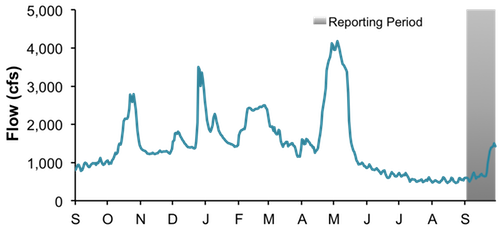
Figure 12. San Joaquin River flow at Vernalis from September 1, 2012, and September 29, 2013.
Figure 13. San Joaquin River daily average water temperature at Vernalis, Mossdale, and Rough 'n Ready from September 1, 2012, and September 29, 2013.
Figure 14. San Joaquin River daily average dissolved oxygen at Mossdale and Rough 'n Ready, from September 1, 2012, and September 29, 2013.
|
Delta Exports
Mean daily pumping at the C.W. Jones Pumping Plant (federal pumps previously known as Tracy Pumping Plant) ranged from 2,589 cfs to 4,206 cfs (Figure 15). Mean daily pumping at the Harvey O. Banks Pumping Plant (state pumps) ranged from 1,588 cfs to 5,319 cfs. Combined total exports (state and federal pumps) during this period ranged from 4,211 cfs to 9,101 cfs.
Figure 15. Daily exports at the state and federal pumping stations from September 1, 2012, and September 29, 2013.
|
|
|
|
|
|
|